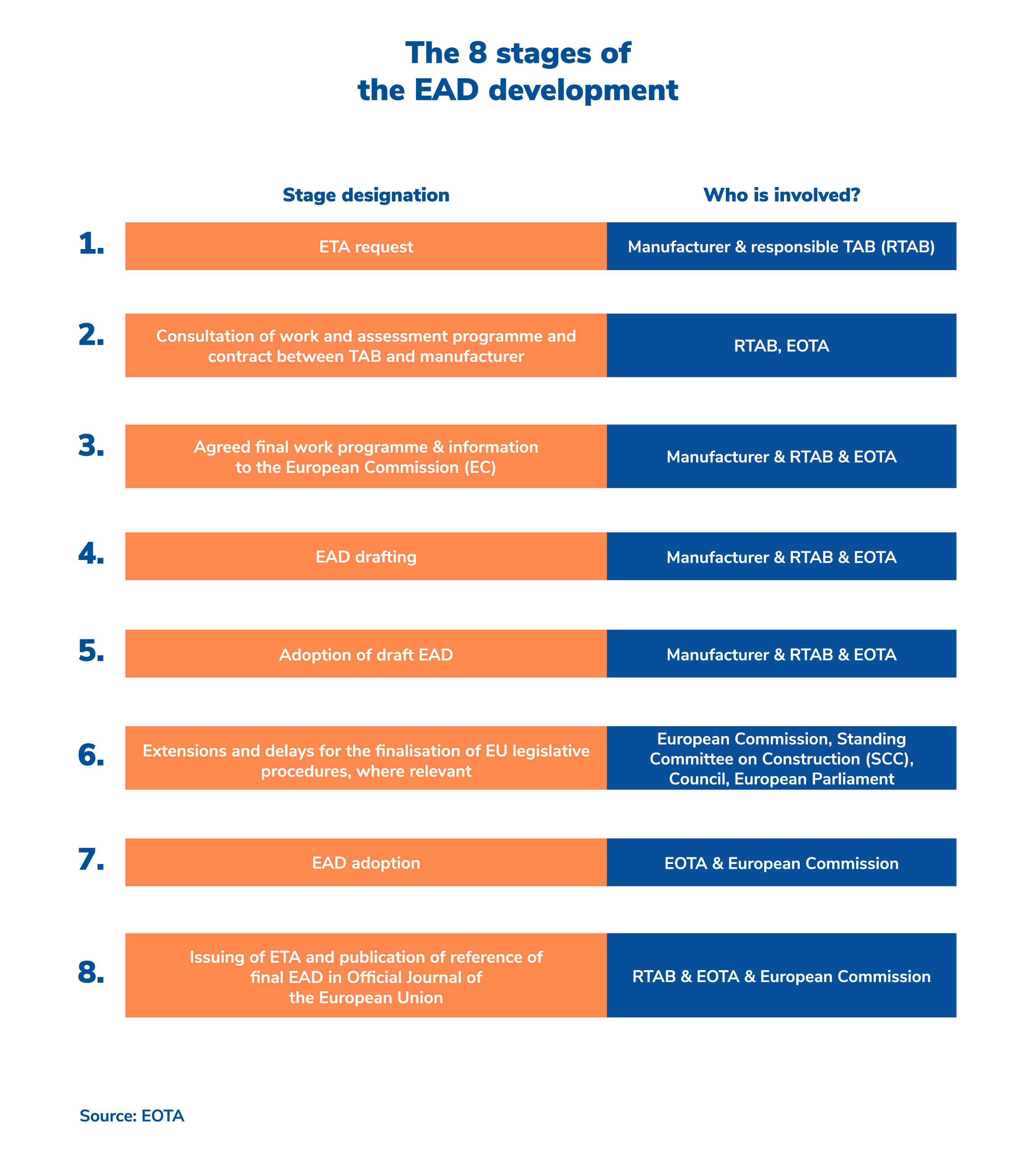A European Assessment Document, or EAD for short, is a harmonised technical specification developed by EOTA as the basis for European Technical Assessments (ETAs).
In combination with the ETA, the EAD provides manufacturers with a way to CE marking for construction products that are not or not fully covered by a harmonised European standard (hEN) under the Construction Products Regulation (EU) 305/2011. The CE marking allows the manufacturer to freely market his product in the entire European Economic Area as well as in Switzerland and Turkey.
Since the CPR came into force until the end of 2021, EOTA has developed 583 EADs based on which the EOTA's Technical Assessment Bodies have issued 10.519 ETAs.
Source: EOTA 2021 Annual Report
Tailor-made
EADs can be tailored to a construction product.
Confidential
The EAD development procedure is kept confidential at your request to protect your competitive advantage.
Free of cost & open access
The EAD comes to you at no extra cost. It is developed as part of the ETA procedure where required. The cost is born by EOTA and its members and co-financed through EU grants. After citation EADs can be downloaded for free from the EOTA website.
Single point of contact
The Technical Assessment Body (TAB) you have chosen for your ETA will guide you through the entire ETA/EAD procedure. The TAB will also be your liaison for the EAD development with the EOTA network.
EAD development procedure – stage by stage
- The development of an EAD is usually triggered when a manufacturer requests a European Technical Assessment (ETA) and harmonised criteria for the assessment of the product's performance are missing.
- From the manufacturer's point of view, the EAD development is handled by the Technical Assessment Body he has chosen as a partner for his ETA. However, a network of highly qualified Technical Assessment experts, the EOTA network, and several other actors operate behind the scenes to bring each EAD along.
- 8 EAD development stages are usually distinguished based on Annex II of the Construction Products Regulation (EU) No 305/2011.

Legal framework
The legal basis for the ETA route to CE marking is the Construction Products Regulation (EU) No 305/2011 (CPR), see in particular, Articles 19, 20, 22, 24 and 25 as well as Annex II of the CPR.
Along with harmonised European standards, EADs have the status of harmonised technical specification (hTS) within the meaning of the CPR (see Art. 2, point 10).
FAQs
An EAD can be developed in all cases where the assessment of a construction product is not or not fully covered by a harmonised technical specification, i.e. a harmonised standard (hEN) or an already available EAD under the Construction Products Regulation (EU) No 305/2011.
The development of a new, or the amendment of an existing, EAD is usually triggered by an ETA request from a manufacturer. If the manufacturer wishes to have the performance of an essential product characteristic assessed for which there is no appropriate harmonised assessment method yet, an existing EAD will be amended or a new one developed.
The TAB chosen by the manufacturer for the ETA project will also be the responsible TAB, or RTAB for short, for the EAD development.
The EADs are developed by the EOTA network consisting of some 45 highly qualified Technical Assessment Bodies (TABs) mandated by their states to issue ETAs. This work is co-ordinated by the EOTA Secretariat based in Brussels.
Further stakeholders, such as the European Commission or the Member States, also have a role to play in the ETA/EAD procedure.
Where confidentiality allows, EOTA also co-operates with external experts and stakeholders to develop state-of -the-art technical specifications for the construction sector (read more on how to become an external expert).
The manufacturer who requested the related ETA has also an important say in shaping the content of the EAD and can provide input at any stage of the process via the TAB of his choice.
In other words, there is a lot of technical, practical and scientific expertise and cooperation going into each stage of the EAD development.
It contains, at least,
- a general description of the construction product and its intended use (Chapter 1),
- the list of essential characteristics relevant for the intended use, methods and criteria for assessing the performance of the product (Chapter 2),
- principles for the implementation of the system for assessment and verification of constancy of performance (Chapter 3).
The usual timeline for the development of an EAD set out in the Construction Products Regulation is 9 months.
The EAD comes to you at no extra cost. It is developed as part of the ETA procedure where required. The cost is born by EOTA and its members and co-financed through EU grants.
During the EAD development procedure, the content and even the fact that an EAD is being developed is subject to confidentiality upon the request of the manufacturer. Only after the first ETA has been issued, EOTA starts making the EAD publicly available.
References to final EADs are announced on the EOTA website once the first ETA has been issued.
Finally, the reference of the EAD is published by the European Commission in the Official Journal of the European Union (OJEU) and provided in NANDO. As soon as the EAD reference has been published in the OJEU, EOTA provides the full text of final EADs free for download on this website.
Additional information
In case you have any questions, please refer to the full list of FAQs on our FAQ page.